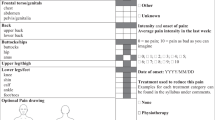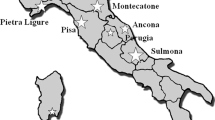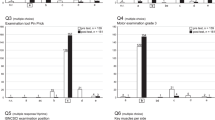Abstract
Study design:
International validation study using self-administered surveys.
Objectives:
To investigate the utility and reliability of the International Spinal Cord Injury Pain (ISCIP) Classification as used by clinicians.
Methods:
Seventy-five clinical vignettes (case histories) were prepared by the members of the ISCIP Classification group and assigned to a category by consensus. Vignettes were incorporated into an Internet survey distributed to clinicians. Clinicians were asked, for each vignette, to decide on the number of pain components present and to classify each using the ISCIP Classification.
Results:
The average respondent had 86% of the questions on the number of pain components correct. The overall correctness in determining whether pain was nociceptive was 79%, whereas the correctness in determining whether pain was neuropathic was 77%. Correctness in determining if pain was musculoskeletal was 84%, whereas for visceral pain, neuropathic at-level spinal cord injury (SCI) and below-level SCI pain it was 85%, 57% and 73%, respectively. Using strict criteria, the overall correctness in determining pain type was 68% (versus an expected 95%), but with maximally relaxed criteria, it increased to 85%.
Conclusions:
The reliability of use of the ISCIP Classification by clinicians (who received minimal training in its use) using a clinical vignette approach is moderate. Some subtypes of pain proved challenging to classify. The ISCIP should be tested for reliability by applying it to real persons with pain after SCI. Based on the results of this validation process, the instructions accompanying the ISCIP Classification for classifying subtypes of pain have been clarified.
Similar content being viewed by others
Log in or create a free account to read this content
Gain free access to this article, as well as selected content from this journal and more on nature.com
or
References
Hicken BL, Putzke JD, Richards JS . Classification of pain following spinal cord injury: literature review and future directions. In: Burchiel KJ, Yezierski RP (eds). Spinal Cord Injury Pain: Assessment, Mechanisms, Management. International Association for the Study of Pain Press: Seattle, 2002; 23: 25–38.
Siddall PJ, Yezierski RP, Loeser JD . Pain following spinal cord injury: clinical features, prevalence, and taxonomy. IASP Newslett 2000; 3: 3–7.
Cardenas DD, Turner JA, Warms CA, Marshall HM . Classification of chronic pain associated with spinal cord injuries. Arch Phys Med Rehabil 2002; 83: 1708–1714.
Bryce TN, Ragnarsson KT . Pain after spinal cord injury. Phys Med Rehabil Clin North Am 2000; 11: 157–168.
Bryce TN, Dijkers MP, Ragnarsson KT, Stein AB, Chen B . Reliability of the Bryce/Ragnarsson spinal cord injury pain taxonomy. J Spinal Cord Med 2006; 29: 118–132.
Richards JS, Siddall PJ, Bryce TN, Dijkers MP, Cardenas DD . Spinal cord injury pain classification: history, current trends, and commentary. Top Spinal Cord Inj Rehabil 2007; 13: 1–19.
Bryce TN, Biering-Sørensen F, Finnerup NB, Cardenas DD, Defrin R, Lundeberg T et al. International Spinal Cord Injury Pain Classification: part I. Background and description. Spinal Cord (e-pub ahead of print 20 December 2011; doi:10.1038/sc.2011.156).
Siddall PJ, Taylor DA, Cousins MJ . Classification of pain following spinal cord injury. Spinal Cord 1997; 35: 69–75.
Siddall PJ, Molloy AR, Walker S, Mather LE, Rutkowski SB, Cousins MJ . The efficacy of intrathecal morphine and clonidine in the treatment of pain after spinal cord injury. Anesth Analg 2000; 91: 1493–1498.
Donovan WH, Dimitrijevic MR, Dahm L, Dimitrijevic M . Neurophysiological approaches to chronic pain following spinal cord injury. Paraplegia 1982; 20: 135–146.
Bryce TN, Ragnarsson KT . Epidemiology and classification of pain after spinal cord injury. Top Spinal Cord Inj Rehabil 2001; 7: 1–17.
Christensen-Szalanski JJ, Bushyhead JB . Physician's use of probabilistic information in a real clinical setting. J Exp Psychol Hum Percept Perform 1981; 7: 928–935.
Lichtenstein S, Fischhoff B, Phillips LD . Calibration of probabilities: the state of art to 1980. In: Kahneman D, Slovic P, Tversky A (eds). Judgment Under Uncertainty: Heuristics and Biases. Cambridge University Press: Cambridge, England, 1982, 306–334.
Ohry A, Brooks ME, Steinbach TV, Rozin R . Shoulder complications as a cause of delay in rehabilitation of spinal cord injured patients (case reports and review of the literature). Paraplegia 1978; 16: 310–316.
Wainapel SF, Freed MM . Reflex sympathetic dystrophy in quadriplegia: case report. Arch Phys Med Rehabil 1984; 65: 35–36.
Gellman H, Eckert RR, Botte MJ, Sakimura I, Waters RL . Reflex sympathetic dystrophy in cervical spinal cord injury patients. Clin Orthop Relat Res 1988; 233: 126–131.
Cremer SA, Maynard F, Davidoff G . The reflex sympathetic dystrophy syndrome associated with traumatic myelopathy: report of 5 cases. Pain 1989; 37: 187–192.
Philip PA, Philip M, Monga TN . Reflex sympathetic dystrophy in central cord syndrome: case report and review of the literature. Paraplegia 1990; 28: 48–54.
Aisen PS, Aisen ML . Shoulder–hand syndrome in cervical spinal cord injury. Paraplegia 1994; 32: 588–592.
Acknowledgements
The following clinicians completed the survey: Liron Bensimon, DPT; Huyen Nguyen Thi Thanh, MD; Karl J Sandin, MD, MPH; William P Waring III, MS, MD; Michael Baumberger, MD; Thomas S Kiser, MD, MPH; Dorien CM Spijkerman, MD; Michael E Acuff, MD; Gregory Allen Nemunaitis, MD; Agostino Zampa, MD; Amrithlal A Mascarenhas, MS, FNB; Luong Tuan Khanh, MD, PhD; Adam Stein, MD; Trevor Dyson-Hudson, MD; Cynthia Nead, COTA; Amitabh Jha, MD, MPH; Giorgio Sanguinetti, MD; Sharon Anne Khor, MBBS, MRM; Isa A McClure, MA, PT; Sergio Aito, MD; Laurie Lindblom, MD; Tim Geraghty, MBBS, FAFRM(RACP); Gelu Onose, MD, PhD; Lisa Harvey, PT, PhD; Gilbert Brenes, MD; Bar-Yoav Merav, MA; Janine Tumminia, PT, DPT; Kevin O’Connor, MD; Jamie Baisden, MD, FACS; Melvin S Mejia, MD; Olufemi Emmanuel Idowu, MBBS, MSc, FWACS; Inger Lauge, MD; Luis Rafael Moscote-Salazar, MD; Giorgio Scivoletto, MD; Ernesto Perrozzi, MD; Kathryn A Stolp, MD, MS; Lance L Goetz, MD; Anna Raizman, RN; Ann-Katrin Karlsson, MD; Fred Maynard, MD; Barbara Garrett, PT, NCS; Mandy Fung, MD; Rikke M Hansen, MD. In addition, 13 clinicians did not request to be acknowledged.
Author information
Authors and Affiliations
Corresponding author
Ethics declarations
Competing interests
The authors declare no conflict of interest.
Rights and permissions
About this article
Cite this article
Bryce, T., Biering-Sørensen, F., Finnerup, N. et al. International Spinal Cord Injury Pain (ISCIP) Classification: Part 2. Initial validation using vignettes. Spinal Cord 50, 404–412 (2012). https://doi.org/10.1038/sc.2012.2
Received:
Revised:
Accepted:
Published:
Issue date:
DOI: https://doi.org/10.1038/sc.2012.2
Keywords
This article is cited by
-
Functional connectivity and amplitude of low-frequency fluctuations changes in people with complete subacute and chronic spinal cord injury
Scientific Reports (2022)
-
Cross-cultural adaptation and validation of the French version of the Spinal Cord Injury Pain Instrument (SCIPI)
Spinal Cord (2022)
-
Association of opioid fills with centers for disease control and prevention opioid guidelines and payer coverage policies: physician, insurance and geographic factors
International Journal of Clinical Pharmacy (2022)
-
Multimodal sensory evaluation of neuropathic spinal cord injury pain: an experimental study
Spinal Cord (2021)
-
Characteristic cerebral structural changes identified using voxel-based morphometry in patients with post-surgical chronic myelopathic pain
Spinal Cord (2020)



